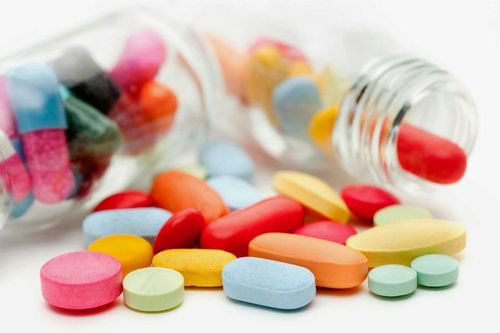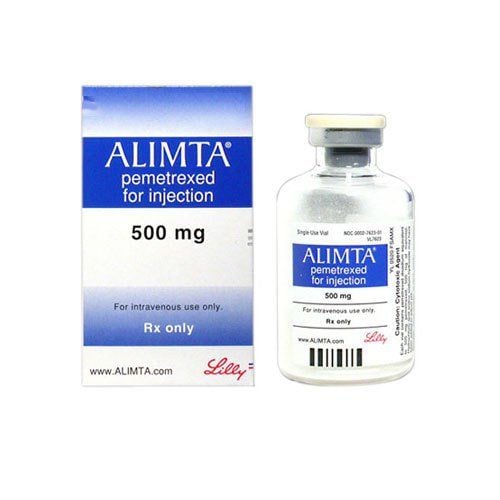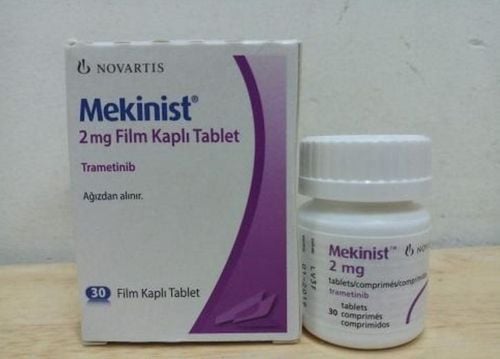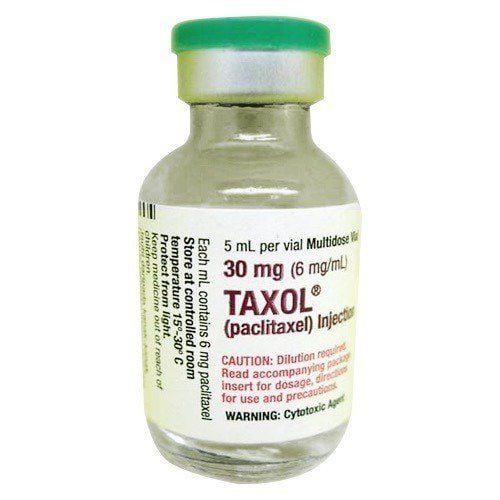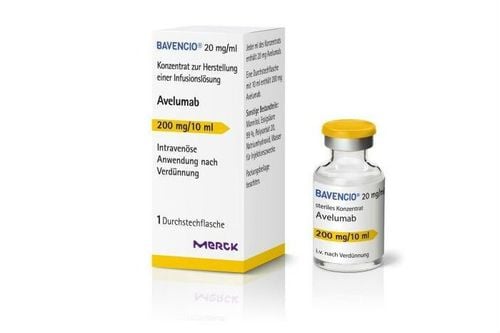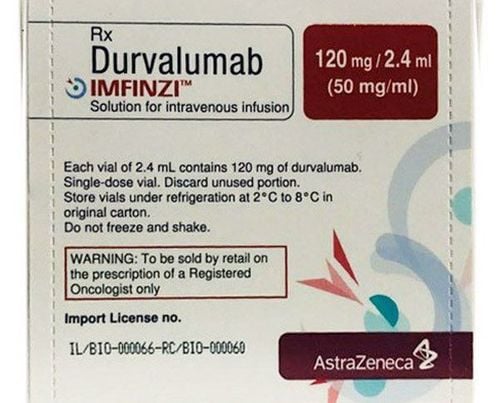This is an automatically translated article.
Endoxan is a medicine that contains Cyclophosphamide, a cancer medicine that interferes with the growth and spread of cancer cells in the body. There is a lot of information on Endoxan products on the market today, but it is still incomplete. To better understand what Endoxan is, what are the uses of Endoxan, let's read more articles below.1. What is Endoxan?
Endoxan 50 mg and Endoxan 500 mg are drugs that contain Cyclophosphamide, a cancer medicine that interferes with the growth and spread of cancer cells in the body.Cyclophosphamide is used to treat certain types of cancer. Cyclophosphamide is also used to treat some cases of nephrotic syndrome (kidney disease) in children.
Cyclophosphamide may also be used for purposes not listed in this medication guide.
1.1. Ingredients of Endoxan 50mg
Cyclophosphamide 50mg Dosage form: 50 mg coated tablets1.2. Ingredients of Endoxan 50mg and Endoxan 500mg
Cyclophosphamide 500mg and 50mg Dosage form: Powder for injection.1.3. Pharmacodynamic
Cyclophosphamide is a cytostatic agent from the oxazaphosphorine group and is chemically related to nitrogen mustard.Cyclophosphamide has no activity in vitro and is activated by microsomal enzymes in the liver to 4-hydroxy cyclophosphamide, which is in equilibrium with its common isomer, aldophosphamide. The cytotoxic effect of cyclophosphamide would be based on the interaction between its alkylating metabolites and DNA.
This alkylation will lead to breakage and alignment of DNA strands and DNA-protein cross-links. During the cell cycle, the transition to the G2 phase is slowed down. The cytotoxic effects are not specific to each phase of the cell cycle, but are specific to the entire cell cycle.
Cross-resistance in particular and to structurally related cytostatics such as ifosfamide as well as other alkylating agents cannot be excluded.
1.4. Pharmacokinetics
Cyclophosphamide is also almost completely absorbed from the gastrointestinal tract. In humans, a single intravenous dose of labeled cyclophosphamide is monitored for 24 hours as plasma concentrations of cyclophosphamide and its metabolites are drastically reduced, although detectable concentrations may persist. in plasma for up to 72 hours.Cyclophosphamide is inactive in vitro and is activated in vivo.
The mean serum half-life of cyclophosphamide would be 7 hours for adults and 4 hours for children.
Cyclophosphamide and its metabolites are also eliminated mainly by the kidneys.
2. What are the uses of Endoxan 50mg and Endoxan 500mg?
Cyclophosphamide is an alkylating agent that belongs to the group of oxazaphosphorines with anti-cancer effects. Cyclophosphamide works by preventing or slowing the growth and development of cancer cells. In addition, this active ingredient also reduces the response of the immune system and is used to prevent rejection after organ transplantation.Indications of Endoxan 500mg Ovarian cancer treatment. Leukemia disease. Patients with breast cancer. Progressive autoimmune disease. Lung cancer treatment. Treatment of multiple myeloma. Endoxan 50 mg is used in a multi- or monotherapy program in: Leukemias Acute or chronic lymphocytic or myeloid leukemia. Malignant lymphoma: Hodgkin's disease, non-Hodgkin's lymphoma, and plasmacytoma. Malignant solid visceral tumors often metastasize and do not metastasize: ovarian cancer, testicular cancer, breast cancer, small cell lung cancer, neuroblastoma, and Ewing's sarcoma. Progressive autoimmune diseases: Such as rheumatoid arthritis, psoriatic arthritis, systemic lupus erythematosus, scleroderma, systemic vasculitis (with nephrotic syndrome) and some forms of glomerulonephritis (with nephrotic syndrome) nephrotic syndrome), severe myasthenia gravis, autoimmune hemolytic anemia, and cold agglutinin disease. Treatment in immunosuppression in organ transplantation.
3. Side effects of endoxan 50 mg and Endoxan 500 mg
Endoxan may lead to a number of side effects including:Loss of taste; Menstrual obstruction; Skin discoloration; Diarrhea ; Hair loss; Nausea, vomiting; Skin rash ; upset or upset stomach; Foundation structure changes; Feebleness; a serious allergic reaction such as rash, hives, itching, trouble breathing, chest pain, swelling of the face, lips, and tongue or throat; Blood in urine ; Bloody or black stools; The amount of urine changes; Infection; Lower back pain or abdominal pain; Swelling or redness at the injection site; Fever chills; Illusion; Pain when urinating; Persistent cough; Pneumonia ; Bruising on the skin; Convulsions; Swollen hands or feet; Short breathing; Unusual bleeding or bruising; Yellowing of the skin or eyes; Platelet decreased ; Impaired immunity and wound healing; The risk of having another type of cancer increases; This will not be a complete list of side effects and others may occur. If you have any questions about side effects, consult your doctor or pharmacist.
4. Interaction
Endoxan injection may interact with a number of other drugs causing increased toxicity, increased side effects, decreased or lost activity.Some drugs that appear to interact with Endoxan to be aware of when taking together are:
Suxamethonium. Allopurinol. Diabetes medication. To avoid unnecessary interactions, what patients should do is provide complete information about the names of drugs or products that you are also taking before using Endoxan.
5. How to use Endoxan 500mg and Endoxan 50mg effectively
5.1. How to use
Endoxan 50mg: Oral medication. Endoxan 50mg Baxter 5x10 sugar coated tablets should be taken in the morning. During or immediately after taking the medicine, you must drink enough fluids to ensure that the patient clears his bladder on a regular basis. Endoxan 500mg is also prepared in the form of a powder for injection, so patients use the drug intravenously. The way to prepare the injection solution is as follows: Mix the powder with 25ml of water for injection. After adding water, shake vigorously so that the powder is dissolved. If it is not immediately or completely dissolved, the solution should be left to stand for a few minutes until it is completely clear. Patients need to strictly follow the instructions of the doctor or pharmacist.5.2. Dosage
Dosage of Endoxan 50mg Continuous treatment from 1 - 4 tablets (50 - 200 mg) per day; If needed, more tablets can be taken. The duration of therapy and/or the interval between courses depends on the indication for treatment, the combination therapy arrangement, the patient's general health and laboratory parameters, and the recovery of the patient. blood cell count. Dosage adjustment recommended for patients with renal or hepatic impairment: Severe renal or hepatic impairment also requires dose reduction. It is recommended to reduce the dose by 25% when serum bilirubin is between 3.1 and 5 mg/100 ml and to reduce the dose by 50% when the glomerular filtration rate is less than 10 ml/min. Cyclophosphamide is filterable. Dosage of Endoxan 500mg Adults and children 12 years of age and older should use a dose of 3-6 mg/kg body weight. The dose for intermittent therapy is 10-15 mg/kg body weight. Each treatment will be spaced 2-5 days apart. For high-dose intermittent therapy, a dose of 20-40 mg/kg body weight or possibly higher should be used. Each treatment will be spaced 3-4 weeks apart. Note: The above dosage is for your reference only. The specific dose depends on the condition and the progression of the disease. To get the right dose, you need to consult your doctor or medical professional.5.3. What to do in case of overdose?
Symptoms: In case of overdose, myelosuppression, mostly leukopenia, may occur, along with other reactions. The severity and duration of myelosuppression will depend on the extent of the overdose. Management Regular check of blood count and patient monitoring is essential. If neutropenia is present, infection prophylaxis must be given, and infection must be adequately treated with antibiotics. If thrombocytopenia occurs, you need to make sure to replace platelets as needed. There is no specific antidote for cyclophosphamide, so extreme caution should be exercised when used. Cyclophosphamide can be dialyzed. Therefore, rapid hemodialysis is indicated when treating all cases of overdose due to suicide or accident. After approximately 6 hours of dialysis, 72% of the administered dose of cyclophosphamide was recovered in the dialysate. Prophylaxis of cystitis with Uromitexan (mesna) is essential to avoid any urinary toxicity.5.4. What to do if you miss a dose?
If you forget a dose, take it the day you remember it. But, when it is almost time for your next dose, skip the missed dose and take your next dose at the same time as scheduled. Note that you should also not double the prescribed dose.6. Notes when using and storing Endoxan
6.1. Attention and caution
Use caution when using the drug for the following subjects:Patients with diabetes. The patient has an infection. The patient has a low white blood cell count. Patients with fluid and electrolyte disturbances. Patients are not allowed to self-medicate, but should follow the doctor's instructions.
6.2. Caution when using for pregnant women and nursing mothers
Do not use the drug on pregnant women and women who are breastfeeding to ensure safety for the fetus and nursing baby.6.3. Preserve
Store the medicine in a place with a temperature below 30 degrees Celsius and do not let sunlight shine directly on the medicine, do not leave the medicine in a place with humidity above 70%. Please check the expiry date before using the medicine to avoid unwanted side effects.Please dial HOTLINE for more information or register for an appointment HERE. Download MyVinmec app to make appointments faster and to manage your bookings easily.




